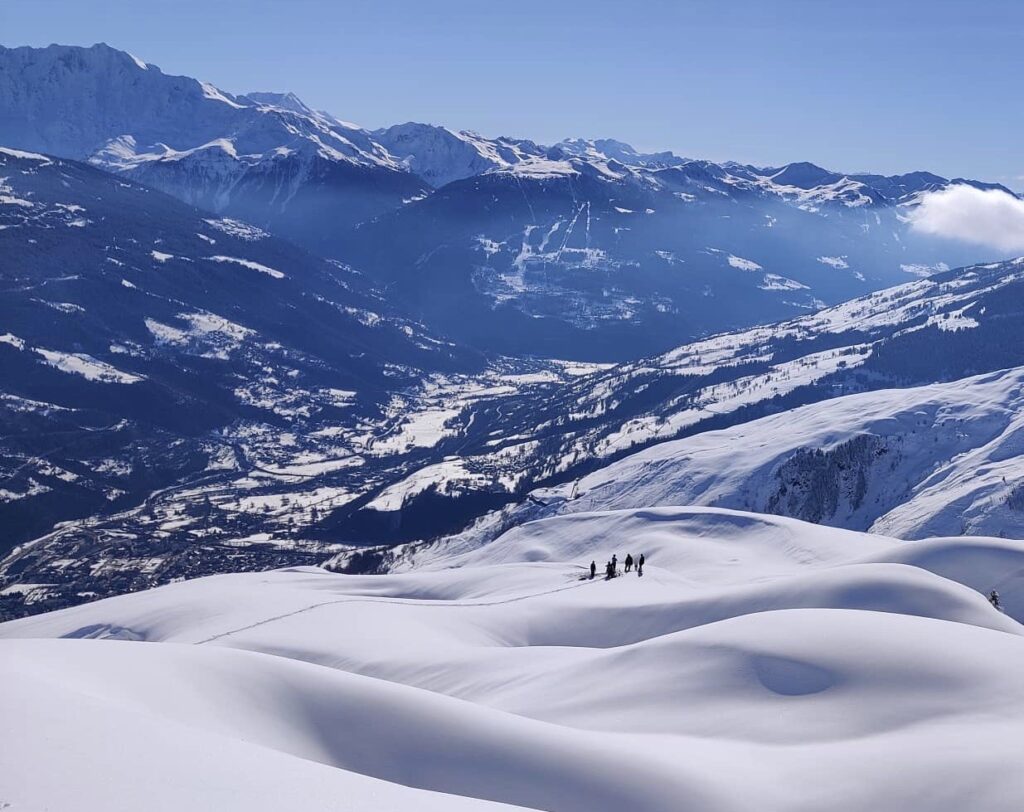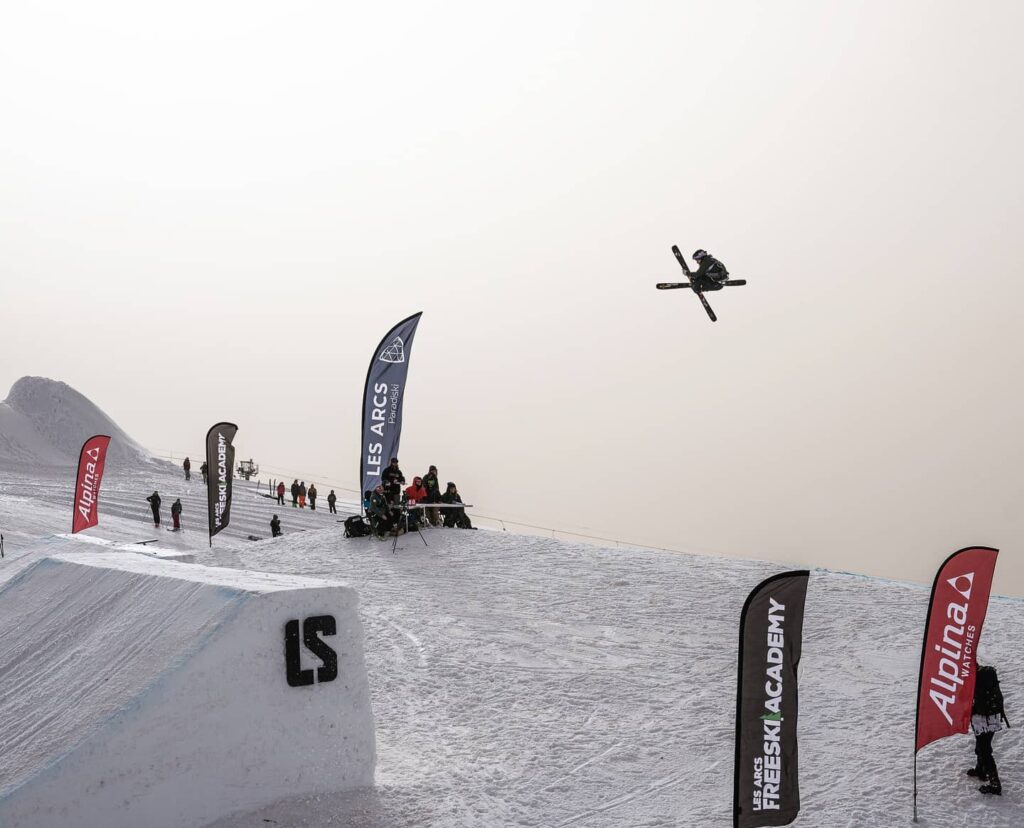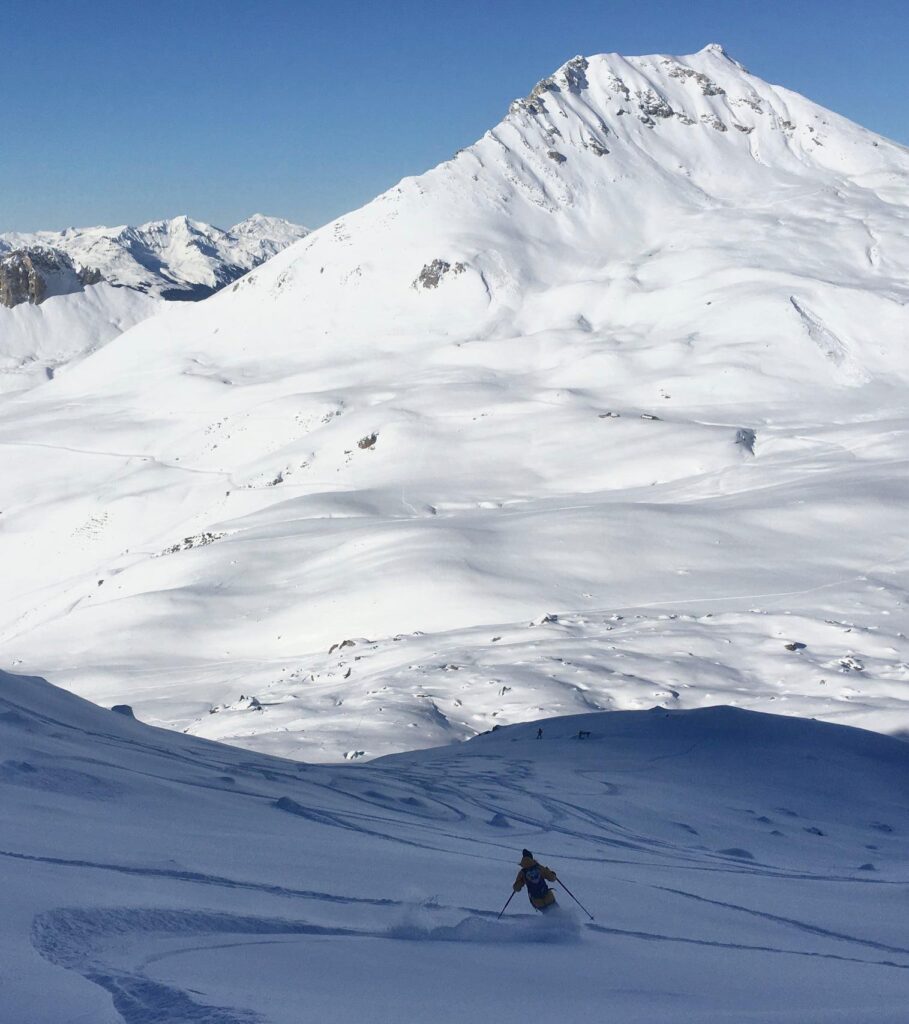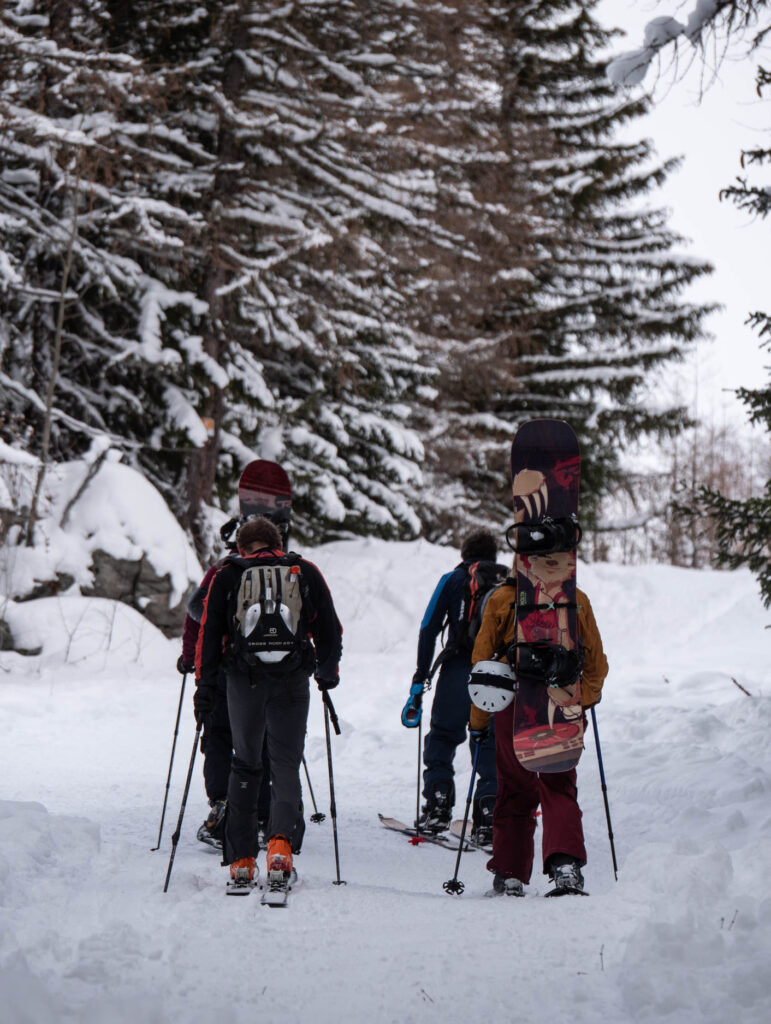2020/21 The Best, Worst Winter
I was tempted to call this “2020/21 – The Season That Never Was”. It’s a snappy title that would strike a note with skiers that aren’t lucky enough to live in the mountains, but nothing could be further from the truth.
To say we didn’t have a winter season would obviously be scientifically inaccurate. After autumn it got cold and white stuff fell from the sky just like it does every year. In fact this year we had great conditions. February was the only month without significant snowfall. Even May has seen regular storms.
It would also be incorrect to say we didn’t have a ski season. Many of us living in the Alps skied as many days as we would during a regular winter. For some, who found themselves without work, the opportunity was there to ski considerably more. There were plenty of periods, particularly during January and March when I was out four or five times a week.

Crew on the sunny side above Bourg St. Maurice. Photo – Colin Black
It’s not even true to say that ski resorts were closed. Some tourists still came here for their holidays. You might be surprised to hear that over the Christmas period, many resorts were boasting bed occupancy of between 20 and 30% (compared to 95% in a normal winter).
So what made this winter different? The small matter of the lifts sitting idle. A monumental decision and one that was met, understandably, with widespread anger locally. The French ski industry accounts for 12 billion euros of revenue annually and supports 200,000 jobs. It can’t have been an easy call but it’s also not hard to see both sides of the argument.
On the one hand, skiing is a sport that takes place outdoors, frequently in sub zero temperatures and with participants wearing gloves and face coverings. On paper it sounds like the perfect sport for a pandemic but that’s only half the story. Opening the lifts would have encouraged huge numbers of people to travel. A normal year sees over 50 million skier visits to French resorts (1 skier visit = 1 lift day pass). Even with bars and restaurants closed (as they were, right across France throughout the winter) the risk of a big jump in infections was substantial.
Many resorts did open one or two lifts, solely for the use of ski professionals and clubs. Again, a decision that met with some backlash but was based on sound reasoning. Local ski instructors and clubs had the opportunity to keep their skills polished without the danger of attracting more tourists. Harder to see the logic when you are hiking up next to a chairlift full of raucous kids from the local ski club though!
Only French ski federation affiliated clubs qualified for this (another sore point) but those that did grasped the opportunity with both hands. The Les Arcs Freeski Academy being a case in point. Even before the Cachette chairlift opened in January, they were out building mini snow parks and shuttling the kids about on skidoos. They clocked up almost as many training sessions through the winter as they would normally and managed to organise the Launchpad Big Air competition in a fenced off snow park. I had the pleasure of DJing at the event and it was almost like things were back to normal for one weekend. Hats off to them.
 Launchpad Big Air comp – photo by Propaganda
Launchpad Big Air comp – photo by Propaganda
A few mountain restaurants and bars took advantage of a loop hole to open up. Drinks and snacks could be ordered from a window and then ‘taken away’, which essentially just meant walking a few metres from the bar before quaffing your pint in the snow. This alone provided motivation for people to get up onto the mountain under their own steam.
The truth is, once the initial shock had passed, life in a French ski resort this winter was pretty damn good. We had the mountains mostly to ourselves, good conditions and, with a little effort, every opportunity to enjoy them.
Now it’s fair to say that ski touring and split boarding are an acquired taste. I remember the first time I went out five years ago. Ninety minutes of fairly inefficient plodding uphill and fifteen minutes of flapping around, trying to convert two planks back into one were rewarded with five minutes of distinctly average descent. An inauspicious start. Later efforts became progressively more rewarding but touring in Les Arcs in May, after the resort had closed, and then putting the first lines down under the Varet, proved the deal clincher. Truth is, you’re not always blessed with perfect powder turns on the way down, so getting to the point where you enjoy the hike up really is key.
[intense_video id=”May” video_type=”wordpresstv” video_url=”https://youtu.be/BhuploNoT-A”]When you tell someone, who doesn’t get it, that you spent three hours hiking up a mountain for a ten minute descent, their reaction is often incredulous – “Why would you do that?” – but think about mountain biking for a minute. Aside from the two months a year when our ski lifts accept bikes, mountain biking around here involves exactly that. We’ll happily spend two hours pedalling up a big hill to spend five or ten minutes riding back down again. Why should skiing and snowboarding be any different?
Two hours of skinning through beautiful alpine forest, and then open mountainside with stunning views in every direction. As you climb, a steady release of endorphins and serotonin reward your exertion, and you arrive at the summit tired but elated. Then, on the good days, you score perfect turns all the way back down, whooping and high five-ing your friends as you arrive back at your starting point.
Sound good? We had so many days like that this winter. A few particular highlights standout.
Hiking up to a 100 year old old army fort through deep untouched powder, tinted golden by the early morning sun and then putting in the first turns back down, in perfect conditions, following the line of a mountain bike descent that we regularly ride in the summer.
[intense_video id=”Fort de la Platte” video_type=”youtube” video_url=”https://youtu.be/m9GI6xh6MI8″]Touring from Arc 2000 in January, up to the Col de la Chal, then fresh turns down the other side all the way to the village of Nancroix before walking to a friends isolated chalet in the forest for Sunday lunch and a boozy afternoon of board games and sledging with the kids.
A three day trip deep into the mountains staying in a mountain refuge that we had all to ourselves right after a big snowstorm. The only tracks we could see were our own. Eating fondue, drinking Genepi and lapping the slope opposite the refuge.
[intense_video id=”Refuge” video_type=”youtube” video_url=”https://youtu.be/KAUwCqXC9vE”]And plenty more. Many of the experiences from this winter have been some of the best in my thirty years of snowboarding.
Why tell you all this? I’m sure for skiers and snowboarders based in the UK, hearing this sort of thing is pure torture, but maybe there’s something to take away from it.
Are we too reliant on ski lifts? The last four months have certainly shown me that it’s not essential for enjoying skiing or snowboarding. I can honestly say, I would be happy getting my snowboard fix using leg power alone for the rest of my days. That’s not to say I won’t use the lifts next winter when they reopen, but if they weren’t there I’d still be snowboarding and enjoying it as much, if not more.
As mentioned above, plenty of tourists still took holidays in the Alps this winter. They went ski touring, snow shoeing and sledging, took husky rides and hired e-bikes with fat tyres. They got paper cups of take away vin chaud and sat watching the sunset over the mountains and then spent evenings in their chalets chatting around the fire with friends and family. They enjoyed holidays in the mountains without going near a cable car.
The sad fact is, the ski industry as it is today, is far from sustainable. Even if all the lifts were powered through renewable sources, they simply consume too much energy for a non-essential pastime. On paper, it does sound like a pretty ridiculous concept. Imagine having to explain it to someone from another planet. “So you use copious amounts of power to transport people from the bottom of a mountain to the top so they can slide back down to where they started? And you say you have a climate crisis?” The Alps are melting and the day when we see the majority of resorts close permanently due to lack of snow is quite possibly already etched onto the calendar.

Lauren Little throwing down some turns opposite the Aiguille Grive
This winter has reminded us that skiing and snowboarding can be sustainable. It requires a lot more effort for a lot less turns but that shouldn’t put you off. The enjoyment you get from the experience as a whole is far greater than it appears at first glance. The mountains can be appreciated without the need to be whisked to the top of them on a heated seat.
Does all of this make any difference? Probably not. The lifts will start turning again next winter and no doubt continue doing so until the last piste has melted away. We’re never going to turn our back on 100 years of investment in resort infrastructure, but maybe it’s time to at least rein in the obsession with continual expansion.
As long as demand for passes increases, resorts will continue to add more lifts and beds, usually without increasing the capacity of their slopes. The result is busier pistes, more accidents and bigger queues, and there’s no doubt this takes something away from the experience.
So perhaps next time you book a ski holiday, consider a day off the lifts. Find somewhere away from the busy pistes and go touring, split boarding or snow shoeing. Ski holidays don’t have to all be about cramming in as many runs as possible. Normal life involves more than enough rushing around so why not use at least one day of your holiday to drop down a gear, get away from the crowds and give yourself a chance to appreciate the quieter side of the mountain?
 December hiking in Les Arcs. Photo – David Billings
December hiking in Les Arcs. Photo – David Billings